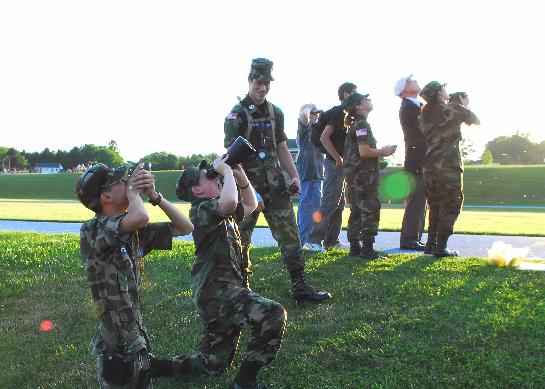|
I first learned about the US Civil Air Patrol - or “CAP” – after 9/11. As a private pilot and long-time aviation enthusiast, I was thrilled to find out that it was possible to volunteer with the civilian component of the US Air Force. CAP’s fifty-six thousand plus members – adult “Seniors” along with 27,000 Cadets
|
 |
| UAV SAREX |
|
|
|
(ages 12 to 21) – are best know for the search and rescue (SAR) and disaster relief missions they conduct with the world’s largest fleet (535) of single-engine, piston aircraft. If a plane goes missing in the continental United States, CAP is mobilized to look for it. Since 9/11, CAP – a non-profit corporation – has been is expanding its role to include an increasing number of homeland security operations and exercises.
Among their bennies, Cadets are entitled to glider and powered orientation flights and can apply for flight training scholarships.
But perhaps the most cool thing about CAP is its Aerospace Education programs for Seniors, Cadets and the general public. If you like learning about or teaching about rockets, airplanes, space, navigation, instrumentation (and the list goes on), you can get more than your share.
As the Aerospace Education Officer (AEO) for the Lone Eagle Composite Squadron in New Jersey, I’ve lead some off-beat sessions with the Cadets. We built a wind tunnel with parts from Radio Shack, the Container Store and a local model railroad shop. We reenacted the Apollo 13 “CO2 air scrubber” emergency with “CapComm” and “Odyssey” teams solving problems using electronic building block sets.
|
 |
| UAV SAREX |
|
|
Most recently, we staged a UAV SAREX (search and rescue exercise) with an R/C park flyer and a mini video camera strapped on transmitting live pictures.
Also, each year CAP sponsors the premier national aerospace education conference National Conference on Aviation and Space Education (NCASE). (visit: http://www.ncase.info/)
CAP: Civilian Dive Bombers of WWII
Civil Air Patrol was conceived in the late 1930s by New Jersey aviation advocate Gill Robb Wilson, who believed in general aviation's potential to supplement America's military operations. With the help of New York Mayor Fiorello La Guardia, the new Civil Air Patrol was established on December 1, 1941, just days before the Japanese attacked Pearl Harbor.
CAP initially planned only on liaison and reconnaissance flying, but the civilian group's mission expanded when German submarines began to prey on American ships off the coast of the United States and CAP planes began carrying bombs and depth charges.
Since radio calls for military bombers were often unproductive, unarmed CAP fliers dived in mock attacks to force subs to break and run.
The CAP coastal patrol flew 24 million miles, found 173 submarines, attacked 57, hit 10 and sank two. By Presidential Executive Order, CAP became an auxiliary of the Army Air Forces in 1943. The U.S. Air Force was created as an independent armed service in 1947, and CAP was designated as its official civilian auxiliary the following year.
A German commander later confirmed that coastal U-boat operations were withdrawn from the United States "because of those damned little red and yellow airplanes."
To find a squadron near you, visit: http://cap.findlocation.com/
Sources:
http://www.cap.gov/visitors/about/our_history.cfm
http://www.cap.gov/visitors/about/our_programs/
http://www.cap.gov/index.cfm?nodeid=6081&audienceID=4
|
Patent pending. (c) 2006, 2007 David Simpson |
|
|